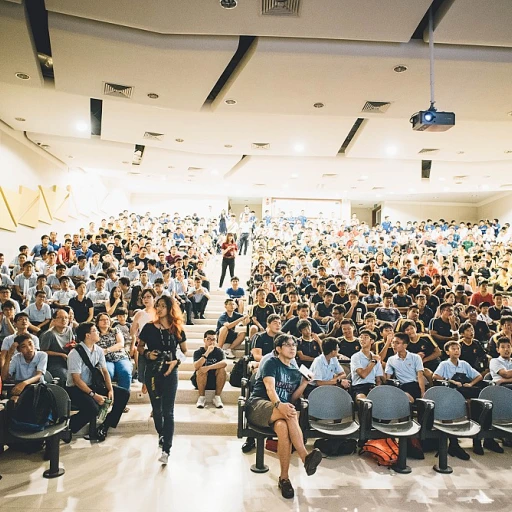
The Evolution of WHF: More Than Just Remote Work
Redefining WHF Beyond Remote Work
In recent years, the concept of Work from Home (WHF) has evolved significantly, extending beyond the traditional notion of remote work. The evolution of desk sharing and flexible workspaces has contributed to this transformation, allowing employees to redefine their work environments. This shift is not just about location; it's about creating a work culture that prioritizes employee well-being and productivity.
Health and Well-being at the Core
As organizations embrace WHF, the focus on health and well-being has become paramount. The integration of health care systems and support for employees' mental and physical health is crucial. Companies are increasingly aware of the impact of work-related stress on heart health, with conditions like heart failure and worsening heart conditions being areas of concern. By prioritizing health, organizations aim to create a supportive environment that fosters both personal and professional growth.
Flexible Work Hours and Work-Life Balance
One of the key benefits of WHF is the flexibility it offers in terms of work hours. Employees can tailor their schedules to fit their personal lives, leading to improved work-life integration. This flexibility helps in reducing stress and improving overall job satisfaction. However, it also requires a clear definition of boundaries to ensure that employees do not experience burnout from being "always on."
Data-Driven Approaches to WHF
Organizations are increasingly relying on data to optimize WHF strategies. By analyzing employee performance and engagement metrics, companies can make informed decisions that enhance productivity and satisfaction. This data-driven approach also helps in identifying potential health risks and implementing preventative measures, ensuring a holistic approach to employee care.
Technological Advancements Enabling WHF
Tech Innovations Driving WHF
The technological advancements in recent years are not just nudging us toward a more flexible way of working, but they are essentially crafting the very definition of WHF (work from home). In the realms where aligning work-life balance with professional commitments is critical, these tech leaps prove to be game-changers. Among the multitude of breakthroughs, certain technologies have notably redefined WHF:- Cloud Computing: By powering remote access to vital data and applications, cloud technology ensures that employees can stay connected with their organizations seamlessly, no matter where they are. This advancement helps in managing both time and tasks efficiently, reflecting on overall productivity.
- Communication Platforms: Tools that facilitate video calls, instant messaging, and collaboration—like Zoom and Slack—have proven indispensable in keeping the team dynamic alive. They bring a human touch to virtual workspaces and enable robust communication against geographical barriers.
- Security Enhancements: As remote work settings become the norm, securing data and privacy has its foundation in next-level cybersecurity measures. These are vital to healthcare, where clinical data must be guarded meticulously.
- AI and Machine Learning: Automated systems tailored for repetitive tasks not only fill the operational gaps but also free up time for employees to focus on more strategic duties.
Productivity and Performance in a WHF Environment
Boosting Efficiency and Outputs in WHF Setups
In the world of WHF, measuring productivity and performance remains a critical focus for both organizations and employees. As working from home (WHF) becomes more prevalent, understanding how this change impacts productivity is essential for sustaining a thriving work environment. While traditional metrics involved tracking hours worked at the office, WHF invites a shift towards evaluating outputs rather than time inputs. This transition reflects a larger trend in new-age work environments where the quality and quantity of a person's contributions take precedence over the number of hours spent "on the clock." To support this shift, organizations are increasingly leveraging data analytics to monitor employee performance accurately. Advanced digital tools and platforms enable employers to gain insights into how well employees work remotely without infringing on privacy. Privacy policy considerations are crucial as organizations collect data on employee productivity to ensure fair and ethical practices. Moreover, focusing on health and well-being plays a pivotal role in sustaining productivity. Initiatives like incorporating breaks for physical activity, ensuring reasonable working hours, and providing access to mental health care help maintain a balance between work responsibilities and personal life. Employees thriving in a caring work environment tend to exhibit better productivity and job satisfaction, benefiting both the individual and the organization. Emerging trends in WHF environments also emphasize the importance of continuous professional development. Investment in training programs and skill-enhancement opportunities for employees enables them to adapt to evolving challenges, fostering an engaged and proactive workforce. For a deeper understanding of how time management tools can aid WHF productivity, consider exploring this resource on developing PTO accrual calculators.Balancing Work-Life Integration with WHF
The Importance of Work-Life Balance in the WHF Era
The shift to work-from-home (WHF) has opened up new doors for creating a healthier work-life balance. For organizations and employees alike, it's crucial to understand the definition of balance within this context. Work-life integration isn't simply about splitting hours equally but ensuring that both work and personal life support health and well-being. With the flexibility that WHF provides, it's possible for employees to fill their schedules in a way that promotes better mental and physical care. This flexibility can contribute to improved heart health and reduce the risk of clinical burnout, fostering a work environment where heart failure and worsening health become less common concerns. The White House's privacy policy adjustments, for example, aim to protect employees working remotely, ensuring their health data remains secure. While the WHF definition may vary across organizations, fostering an environment that prioritizes both productivity and personal care is key. Some might picture a setting filled with the temptation to slack off, to enjoy frequent breaks with whey protein shakes or delicious meals during work hours. However, an effective WHF system is about allowing employees the freedom to manage their time wisely, balancing moments of focused work with necessary rest and relaxation. The importance of leadership cannot be overstated, as leaders play a significant role in shaping how work and life fuse in a WHF setup. They must encourage an atmosphere where employees feel supported rather than overworked, ensuring their efforts bring value to both personal and organizational goals. The approach to WHF must be backed by data-driven strategies that guarantee employee health is always at the forefront. Keeping people's health at the center of WHF definitions demands careful management. Organizations should promote activities that keep hearts healthy and spirits high, turning potential issues of failure into success stories. Balancing tasks across the professional and personal spectrum should aim to foster well-being, just like the heart foundation and events by the heart federation initiate care systems to buffer against clinical pressures. Ultimately, navigating the future of work and understanding the full potential of WHF demands a holistic approach. Careful integration of work and personal life can create an environment where employees thrive, organizations prosper, and heart federation benchmarks are met. It is through this balanced lens that WHF holds the potential to become a core component of the workplace landscape.The Role of Leadership in a WHF Setting
Guiding the Workforce with Effective Leadership
In a WHF setting, the role of leadership takes on a new dimension of complexity and importance. As defined by the new work-from-wherever models, leaders must be adept at steering their teams through digital landscapes while ensuring both organizational goals and individual health and wellness are prioritized. Effective leaders in all organizations understand their employees not merely as workers but as individuals with varying needs and capabilities. This understanding requires a balance between clinical data-driven decisions and the human side of management. Leaders often need to shift from traditional supervisory roles to more of a coaching or mentoring approach. Key Attributes of WHF Leadership:- Communication Clarity: Leaders must fill the gaps of physical absence with clear and consistent communication. Setting definitional foundations for "work hours" and "off time" is essential to prevent employee burnout and maintain work-life balance.
- Health-Centric Approach: Considering factors like high-pressure environments and potential heart failure due to stress, leadership should promote wellness initiatives. Encouraging breaks and a healthy work pace helps avert worsening heart conditions.
- Empathy and Care: Understanding individual employee challenges, personal circumstances, and potential health issues is vital. Sensitivity to heart-wrenching life situations can build trust and rapport within the team.
- Adapting Work Definitions: As federations and definitions WHF evolve, so should leadership strategies. Leaders should stay informed about WHF events, the latest definitions, and potential implications on productivity and health.
- Agility and Flexibility: Leaders must oversee post-pandemic shifts, ensuring their policies are aligned with a white paper approach, balancing institutional goals (like those in a white house) with individual well-being.












